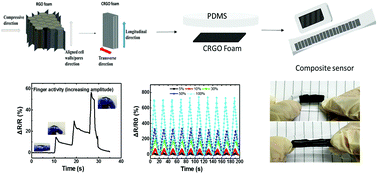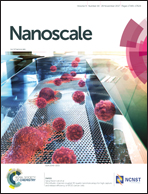Highly stretchable, sensitive strain sensors with a wide linear sensing region based on compressed anisotropic graphene foam/polymer nanocomposites†
Abstract
Nanocomposite strain sensors composed of compressed honeycomb-like reduced-graphene-oxide (RGO) foam embedded in polydimethylsiloxane are facilely fabricated via unidirectional freeze-drying and simple mechanical compression. The microstructural characteristics of the nanocomposites endow the sensors with excellent flexibility, high stretchability and sensing sensitivity, as well as anisotropic mechanical and sensing performance when stretched along directions vertical and parallel to the aligned RGO cell walls (defined as transverse and longitudinal directions, respectively). In particular, the compression of the aligned RGO foam into a thinner film results in more conductive pathways, greatly increasing the sensing sensitivity of the nanocomposite sensors. The sensors stretched along the transverse direction show an outstanding combination of high stretchability over 120%, wide linear sensing region of 0–110% and high strain sensing sensitivity with a gauge factor of around 7.2, while even higher strain sensitivity and lower sensing strain are exhibited along the longitudinal direction. Sensitive and reliable detection of human motions is also successfully demonstrated using these light-weight thin-film nanocomposite sensors.



 Please wait while we load your content...
Please wait while we load your content...